
Observed: C(l)
At this point we can have a little fun. Since the early Universe is such a poor musical instrument, with its hopelessly broad harmonics, why not give it some help and tailor the sound to a human ear — namely, sharp spikes in the sound spectrum. The next diagram and associated sound files include a version of P(k) (shown in yellow) in which the broad fundamental and harmonics have all been replaced by narrow spikes – single pure tones – of the correct relative amplitude, to fabricate a "chord" that our ears might recognize. Try playing that chord now (the yellow button) and compare it with the same sound with broad harmonics (green button):

|
Observed: C(l) |
Well, what's the verdict? Hmm... not too pleasing to the ear, but then not wholly discordant either. Take a careful look at the location of the peaks — although the higher harmonics are well behaved and equally spaced, the gap between the fundamental and the second harmonic is bigger! This is quite unlike most objects or instruments we are familiar with, and so the sound is strange to our ears.
To analyze the chord further, we need to take ratios of the frequencies of the component notes. For the first two we find an interval somewhere between a major 3rd (octave + 4 semitones) and a minor 3rd (octave + 3 semitones). Rather poetically, when the Universe's music was first etched on the CMB for all to see, it was suspended between a state of buoyancy and sadness.
Of course, the chord you just listened to was played only at the time of the CMB — just a single moment in an evolving concert. This is not the best way to listen to music – turn the radio briefly on and off once in the middle of a concert!
What was the chord sequence – did it change, and if so how? As before, we can use CMBFAST to follow the evolving chord — simply take the sequence of calculations, and measure the frequencies and amplitudes of, say, the first eight harmonic peaks. The next diagram and sound shows the evolution of these harmonics over the first 400,000 years.
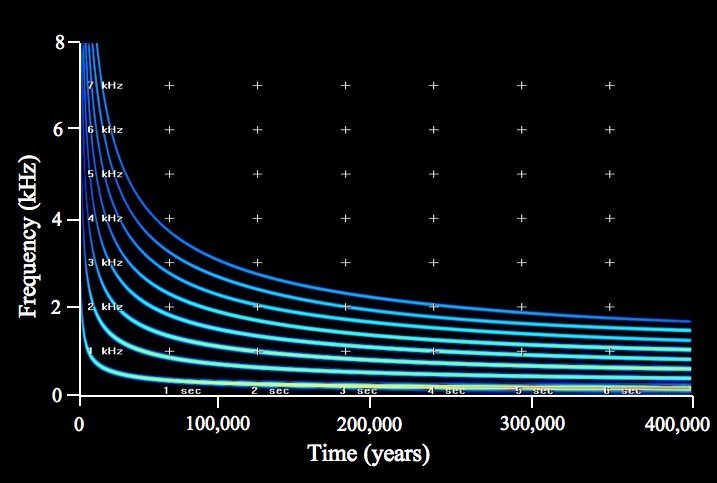
|
Click image for details
|
Well, we certainly hear the steady drop in pitch — the "descending scream" — but now in a form like a sliding whistle. As with the previous broad harmonic version, the drop in pitch settles down and only then can we more easily hear the "chord".
A more playful way to display this "musical" version is to make the frequency (y) axis exponential — because that is closer to the way in which musical notation is given. The figure below shows this — notice how the frequency axis can now be accurately matched to normal musical notation, as well as a piano keyboard (check that "concert A" is at 440 Hz, and each octave is a factor of 2 in frequency).
In this version, the time axis is also exponential, and the associated sound follows this axis smoothly — 2 seconds for every factor of 10 jump in time, from 104 years to 105 years to 106 years. With this kind of time flow, the pitch seems to drop steadily, rather than rapidly, as it does in the version with "normal" linear time.
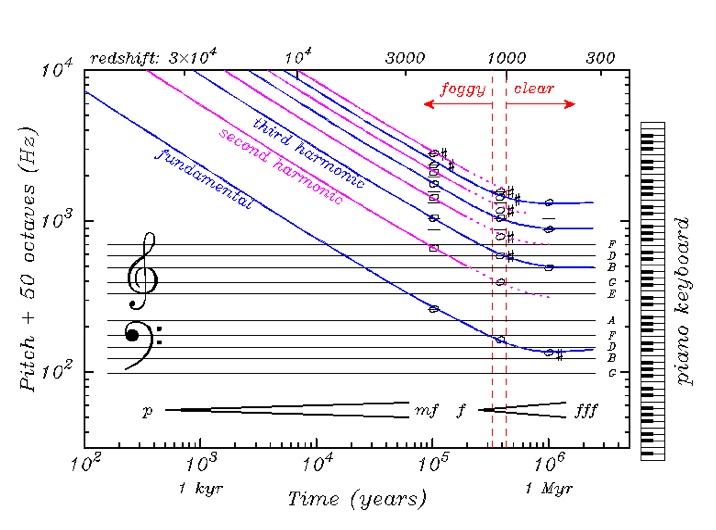
|
Click image for details
|
Next you'll find a somewhat different version which I created to help two musical artists with their compositions (Casey Tang in New York working with a Player Piano, and Ander Mikalson in Richmond working with an eight voice ensemble). Here, 400,000 years are mapped onto 5 minutes with linear time, and the pitch is adjusted so that the fundamental tone at 380,000 years is 110 Hz (two octaves below concert A440). As the 8 harmonics drop past each note on the piano, that note is sounded. The notes fade away but not completely, so one can also hear the chord of all notes slowly changing. Note: at late times the fundamental tone is too deep for most onboard computer speakers, so you'll need headphones or external speakers to properly hear this.
The graph shows the descending harmonics, with red dots when each new note is played (even harmonics, which fade away, are shown with dashed lines). The left scale gives the pitch while the right scale gives the volume of each harmonic (shown by the blue lines). Vertical purple lines are spaced at 30 second intervals to help you match up the sound to the graph, though it's best to open the sound file using Quicktime and stretch the window and align it with the graph x-axis.
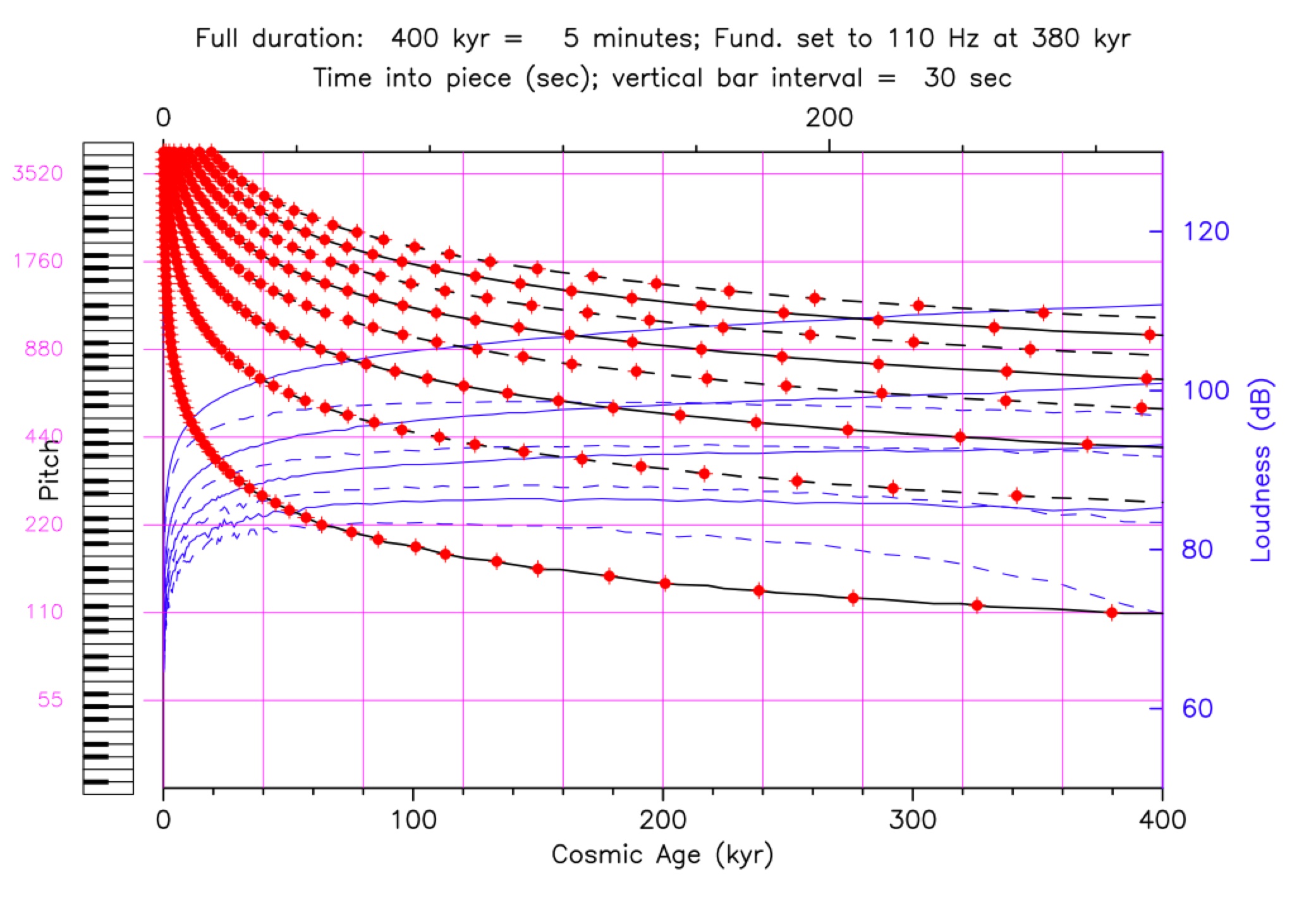
|
Click image for details
|
Now, with all these "musical" versions it's quite difficult to tell whether the chord is changing much or not, because the drop in pitch masks our perception of the chord. In fact, if you look at the spacing between the harmonics, it's roughly the same throughout the entire time, and this means the chord isn't changing very much. That's because musical intervals are defined by frequency ratios, which correspond to a fixed separation on this kind of diagram, with exponential frequency axis.
So, if we're going to hear the evolving chord properly, we need to somehow remove the downward drop.....
The next figure achieves this by anchoring the fundamental to a single note (A 220 Hz), keeping all the other harmonic spacings the same, which preserves the chord while removing the drop in pitch. I've shown the corresponding notes at intervals, as well as a compact version with all the notes in a single octive (blue notes).
There are three versions of this sound. The "microtonal" version (red button) follows the pitch of the harmonics exactly. The "even tempered" version (yellow button) forces the harmonics onto the nearest note in our western "even tempered" (12 semitone) scale. The "even tempered single octave" version (blue button) is similar, but puts all harmonics into a single octave with the fundamental at the bottom. More details of this "microtonal" and "even tempered" mode are given here.
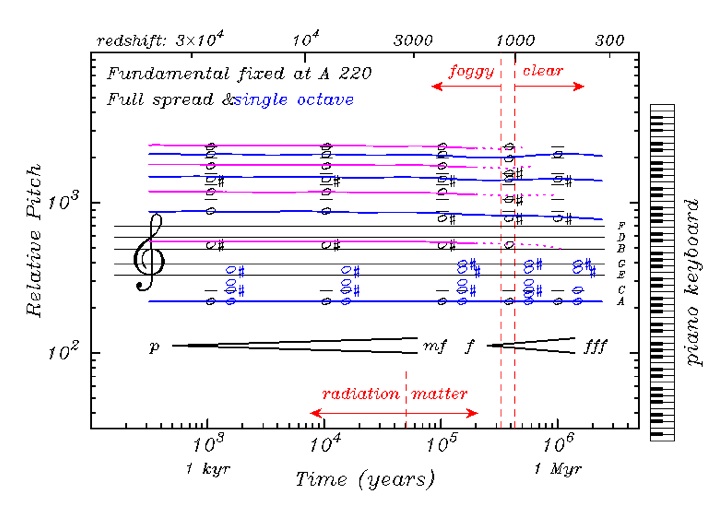
|
Microtonal |
In all cases, the chord slowly changes as the acoustic oscillations gradually readjust to the changing cosmic conditions. The even tempered versions introduce a somewhat artificial sense of rhythm as the notes jump to the nearest note on our musical scale. To my ear, the last compact (single octave) version seems the most eerie.
So... what kind of chords do we find? Quite an interesting mix, really. The primary interval (bottom two notes) starts as a major 3rd and evolves to a minor 3rd – a classic modulation. However, the other notes in the chord introduce significant "richness". For example, in the opening 105 years, the full chord includes both a major 3rd and a minor 3rd – both moods are present simultaneously. At later times, as we approach the time of the CMB, other notes are incorporated which give some very interesting forms. Incidentally, the chords sound much "better" when played on a piano rather than than using these pure tones, which inevitably give a "synthesizer" feel.
You'll notice that the last two figures also include dynamic notation, indicating a change in volume — a slow initial crescendo, from "piano" to "mezzo-forte", and then a more dramatic crescendo, from "forte" to "fortissimo". These match, of course, the earlier description for the full sounds: "a descending scream building into a deep roar, which becomes a cacophonous hiss". The next figure shows the crescendo quantitatively.
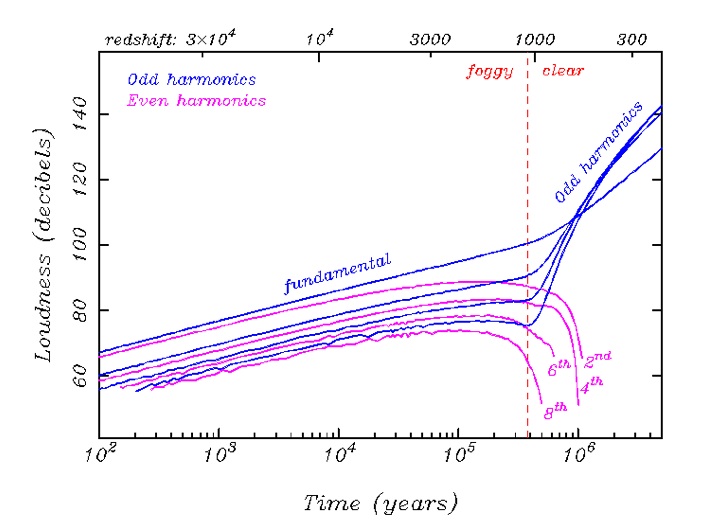
|
What the musical notation cannot reveal is a rather curious phenomenon — the odd and even harmonics behave differently. While the odd harmonics (which include the fundamental) continue to grow in strength, the even ones decrease and ultimately disappear shortly after the fog clears.
Why is this? Recall from topic 6, even harmonics arise from clumps caught at maximum rarefaction, while odd harmonics arise from clumps caught at maximum compression. Now, as time marches on, light's pressure drops relative to matter's gravity, and with pressure reduced the gas can't bounce out of the valleys as easily, so the rarefactions get weaker, muting the even harmonics. Conversely, gravity helps gas fall into the valleys, strengthening the odd compression harmonics. When the fog clears, light's pressure drops to zero, and the rarefactions are killed completely. You can also see this behavior in the diagrams and movies of topics 10 and 11.
All musical instruments generate a series of harmonics — preferred frequencies which arise from the various ways in which the instrument vibrates. However, the actual sequence of frequencies can vary greatly from one instrument to the next. Instruments which rely on a vibrating string (e.g. violin or guitar) or a column of air (e.g. flute or clarinet) have a set of equally spaced harmonics, with the nth harmonic having frequency: fn = n × f1 where f1 is the frequency of the lowest harmonic (i.e.the fundamental). One might call these "perfect" harmonics, since their equal spacing makes them sound clear and pleasant. Other instruments (e.g. drums, bells, cymbals) have a more complex set of harmonics (called "partials") which don't have a simple relation, and yield a more complex pitch and sound.
To what category of instrument does the Universe belong? It is much more like a flute or violin than a drum – its harmonics form an almost perfect sequence.
But not quite! The lower harmonics are progressively below the fundamental expected from the upper harmonics, by about a semitone for the 2nd harmonic and about 5 semitones for the fundamental. The next slide shows the situation by plotting the "reduced" harmonic locations: fn/n for the nth harmonic. Notice that they fall to the right of the true fundamental. The "missing" note that these reduced harmonics point to is sometimes called a "Ghost" or "Strike" tone — our brain will sometimes "hear" it, even though it doesn't actually exist.
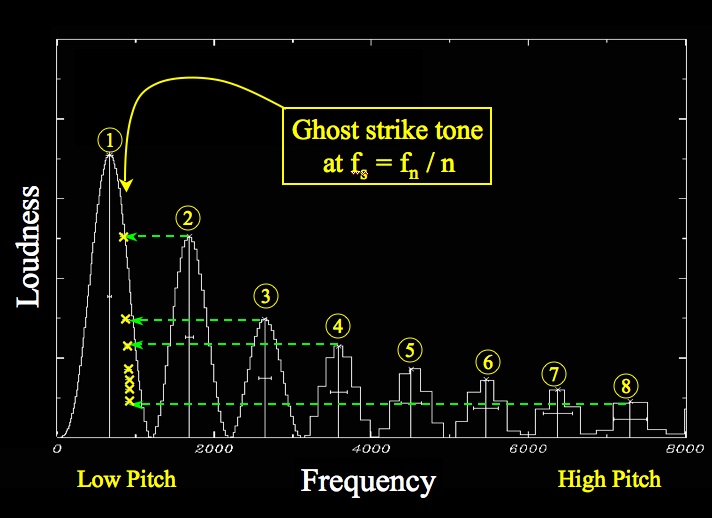
|
Click image for details
broad ⇔ narrow narrow ⇔ even above f1 narrow ⇔ even above fS |
The three sounds explore the inharmonic nature of the sound. The first compares the broad harmonics with the narrow ones, all at their correct pitch (green button). The second and third compare the sound with narrow harmonics at the correct pitch with the sound from evenly space harmonics above the true fundamental (white button), and evenly space harmonics above the ghost strike tone (black button).
As you will learn by clicking on the image: this phenomena whereby there are two fundamentals – a true one, and a ghost one arising from the upper partials – is a property of some bells and bars.
The figure below shows the time development of what one might call "reduced harmonics" — the set of "fundamentals" for each harmonic, or in math form: the set of tones with frequency fn / n. The higher harmonics have similar reduced frequency, which is set to A440 Hz, while the second harmonic and true fundamental are offset to lower frequency. The two sounds give the changing sound in both microtonal (red) and even tempered (yellow) forms. In each case the time unfolds exponentially, from 1000 years to 3 million years.
This gives an alternate version of the chord evolution. Previously we set the true fundamental to the unchanging A 220 Hz. Here we set the strike tone to be the unchanging A 440 Hz.
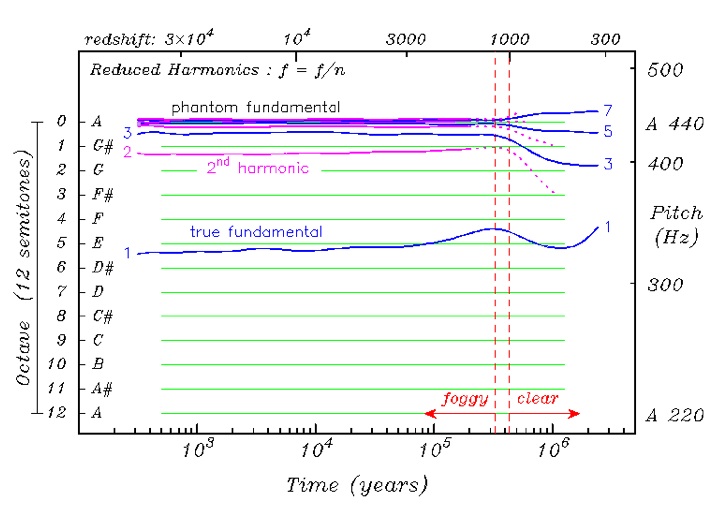
|
Click image for details
Microtonal Even Tempered |
OK, that's enough with this recreational interlude exploring the musical aspects of primordial sound. Back to the real business — how this sound makes stars and galaxies!